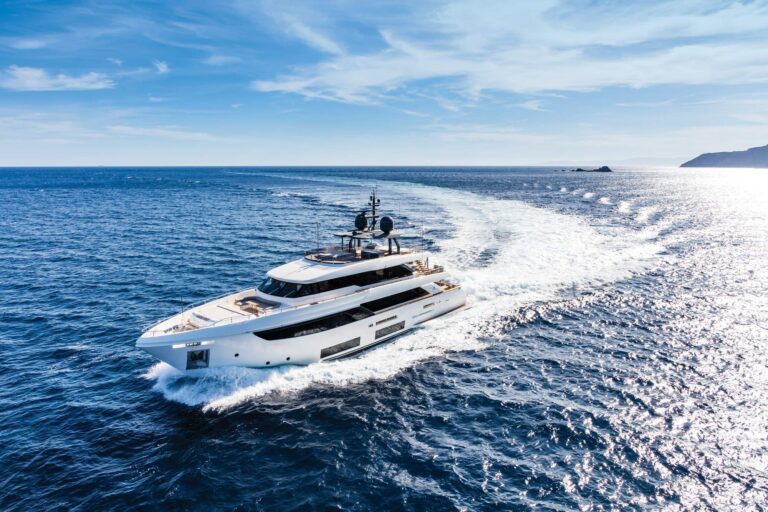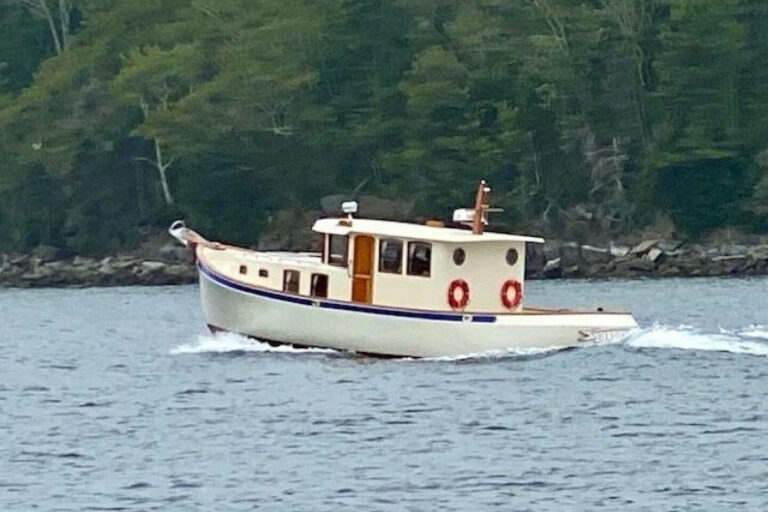
ROOM TO MOVE: By moving the pilothouse forward, Sunseeker added a lot of internal space without sacrificing the sleek lines its boats are known for.
Sunseeker has always been more of a trendsetter than a follower, and its motoryachts manage to have that extra zing that makes them stand out from the crowd. It’s not just the style of its sport yachts but also their performance that have made this British builder legendary. So, I was expecting something special on this latest sea trial.
However, the new Sunseeker Manhattan 60 flying bridge cruiser delivers a more stately experience than the company’s sport cruisers do. It is a perceived wisdom among virtually all boatbuilders that if a yacht has a flying bridge then there is no requirement for speeds over 35 knots. Thirty knots is more the average in this category and here the Manhattan range is no exception. Although I wasn’t expecting anything special in the way of speed, I was expecting something special about the styling.
And the 60, the latest in a revamped line of Manhattans, comes through with buoyant and exciting exterior styling. Even though the company has moved the pilothouse well forward on this boat in order to enhance the internal space, the lines still appear extremely well balanced and attractive. Looking from the outside you would be proud to be the owner. Boarding from the transom, you’ll be bound to make a grand entrance, a Sunseeker specialty. The interior, though, is less splashy than those I’ve seen on Sunseeker’s sportier boats.
Heading in through the sliding doors from the cockpit, you are greeted by what seems an enormous space stretching right up to the windscreen. This open-plan area is divided into two seating areas, and Sunseeker has reversed the normal layout of lounge seating aft and dining table forward. The two areas can be used for lounging, and the aft one has an opening table that allows it to be converted into a full-blown dining area. The flat-screen TV and the drinks cabinet are built into the sideboard to emphasize the area’s social function.
The upper array of seating consists of two curving settees with the passageway between them leading into the helm station. At the helm there is just one seat, although it is big enough to be used as a double if the people sharing it are good friends. Alongside the helm there is open space to allow light down into the galley below. The deep side pillars of the outside door behind the helm strike a rather jarring note: They break up the flowing lines of the interior and look out of character with the rest of the styling.
The helm has been well laid out with the engine instrumentation and the controls central around the wheel and the navigation displays on a separate panel off to the left. Visibility from the helm is reasonable except aft, where the deep, wide windscreen pillars do intrude a bit.
The galley is one of the best parts of this boat. With plenty of space it is fully equipped for sophisticated meal preparation, but it is also the passageway to the cabins, so it could get crowded down here at times. Space could have been more organized: This 60-footer only has three staterooms instead of the four you would normally expect on this size yacht. I can see some alternative layouts being developed for the Manhattan in the future.
Going aft from the galley you come to the full-width master, a generous space complete with large bathroom and closet. Opposite the galley is a twin berth cabin that also has an en suite bathroom with a second door, allowing it to be used as the day head. Forward is the VIP cabin that has quality to match the master, but is more compact. In all three staterooms, the bathrooms are well sized, but headroom is a bit tight in the master stateroom with part of the cabin having barely standing height for anyone over six feet tall.
Up on the flying bridge, everything has been kept low to reduce the profile; you can only operate the helm when sitting down because the wheel and throttles are set so low. This is perhaps just as well because if you were standing you would likely block the beam from the low-set radar on the aft mast. (This radar is going to be partially blocked at the sides anyway by the two satellite domes mounted there.)
The reverse-angle windscreen on the flying bridge offers little protection from the wind at speed, and I would worry a little about the security offered by the low side bulwarks. However, there is no lack of seats in the sun up here and the tender is taken care of by a hydraulic lifting platform on the transom, so every inch of the flying bridge can be dedicated to pleasure.
The 60 posesses plenty of low-speed punch to get it up on the plane, aided by the five-bladed wheels. There is no holding back once the throttles are opened and the top speed comes in at 31.5 knots, but this should pick up once new wheels are fitted. The 60 was fresh out of the yard when I did the sea trial, and no doubt a number of modifications are planned in addition to these enhanced propellers.
One of these changes is likely to be with the steering, which on the prototype was very sensitive, making it difficult to hold a steady course without a lot of concentration. It would be a simple matter to change the steering ratio. This sort of adjustment is normally carried out away from the media gaze, so I will not be too critical since I was allowed an early view of the yacht.
With the wind blowing at 25 knots it was a good day to test the seagoing ability, although the big swells had not built up over the 30-mile run we did in the English Channel. The boat feels very safe and secure, and while you can sense the water slamming on the wide chines when you push the boat hard, this can be a good warning sign: a suggestion that it could be time to ease up on the throttles a little. The deep-V hull keeps the spray well under control, thanks to the secondary chine built into the lower topsides.
Even in the strong winds, low-speed handling was positive and true, aided considerably by the powerful bowthruster. The 900 hp MAN diesels run smoothly and are installed with the drive taken through a V-drive gearbox and then aft to conventional propellers in semi-tunnels.
Although I feel there is still work to do on this design, the basic concept is very sound and promises the level of excitement that you’d expect from this long-established builder. I did find it difficult to reign in my expectations, having been to sea on several of the top-of-the-speed-range Sunseekers, but this is a flying bridge yacht that looks the part and acts it extremely well.
Contact: Sunseeker, www.sunseeker.com









